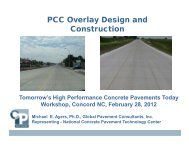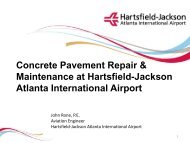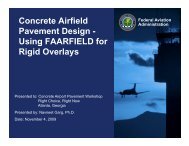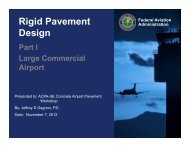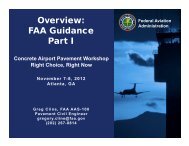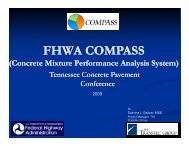Concrete
Concrete
Concrete
You also want an ePaper? Increase the reach of your titles
YUMPU automatically turns print PDFs into web optimized ePapers that Google loves.
2009 <strong>Concrete</strong> Pavement Workshop<br />
Atlanta, Georgia – November 5, 2009<br />
Best Practices for<br />
Construction of<br />
Airfield PCC<br />
C Pavements<br />
By: Shiraz Tayabji<br />
Fugro Consultants, Inc., Columbia, Maryland, USA.
‣Jointed<br />
Airfield <strong>Concrete</strong> Pavements<br />
• As-designed service life ~ 20 years; anticipated<br />
service life ~ 25 to 30+<br />
years<br />
• 12 to 25 ft joint spacing<br />
• t=8in(GA)to16-20 to in (Hub) to 20+ in (Military)<br />
• Less than 20 by 20 ft;<br />
old about 25 by 25 ft<br />
• Dowel bars at longitudinal joints<br />
• And, at transverse joints for wide body aircraft<br />
• Stabilized base common at hub airports
Airport <strong>Concrete</strong> Pavement<br />
Performance<br />
Requirements<br />
‣ Structural performance<br />
e – low level of cracking<br />
(BY DESIGN)<br />
‣ Material performance<br />
– concrete durability –<br />
minimize joint & crack spalling<br />
‣ Safety – maintain frictio<br />
on properties & minimize<br />
hydroplaning potential<br />
‣ Smoothness – minimize<br />
dynamic forces (g<br />
forces) in the aircraft<br />
‣ Reduce/eliminate i FOD<br />
(foreign object damage)
Airfield Pavement Performance<br />
Service<br />
eability<br />
(PCI)<br />
Deficient<br />
Materials and/or<br />
Construction<br />
10 yrs<br />
Threshold<br />
Level<br />
As-designed<br />
Time<br />
Owner<br />
Expectation<br />
20+ yrs 30+ yrs<br />
UGRO
How do Airfield <strong>Concrete</strong> Pavements Fail<br />
Early age failures (within<br />
few days)<br />
•Cracking<br />
•Spalling<br />
In-service failures (20 to<br />
30 years)<br />
•Cracking g - aircraft loading<br />
•Spalling<br />
•Materials related distress (ASR, Deicer)<br />
•Roughness<br />
•Safety y needs
Spec Role - Avoiding Future Problems<br />
Pavement failure should be a result of structural distress<br />
(repeated aircraft loadings)<br />
and not due to concrete<br />
material, support or construction related defects
Outline<br />
Recent IPRF Construction Related Findings<br />
Specificat<br />
tion Intent<br />
End Product Requirements<br />
Quality in Construction<br />
Construction Best Practices (Selected)
Over-riding Assumptions<br />
for IPRF<br />
Studies<br />
‣The constructed pavem<br />
ent will be durable for all<br />
concrete mixtures, placement and finishing<br />
techniques, project size<br />
or climatic conditions.<br />
‣The pavement will exhib<br />
bit failure due to<br />
anticipated aircraft loadings over the design<br />
period and not due to material deficiencies.<br />
Thus, durable concrete is that concrete that will<br />
not exhibit materials rela<br />
ated failures during the<br />
service life of the pavement.
Over-riding Assumptions<br />
for IPRF<br />
Studies<br />
‣Thus, s primary focus of I<br />
PRF studies has been on<br />
improving concrete materials technology and<br />
improving ing construction ction process, including process<br />
control and acceptance testing procedures<br />
‣Addressing hot/current issues to meet stakeholder<br />
needs
Gaps in Construction Technology<br />
Addressedd by IPRF<br />
‣ Best practices guide<br />
‣ Early age strength<br />
determination (maturity)<br />
‣ Stabilized base interface<br />
‣ Rapid rehabilitation<br />
‣ Proposed construction<br />
spec (P-501X)<br />
‣ Deicer related materials<br />
requirements<br />
‣ <strong>Concrete</strong> flexural strength<br />
‣ Deleterious materials limits<br />
‣ Flyash in concrete<br />
‣ Airfield pavement<br />
smoothness<br />
‣ Recycled materials for base<br />
‣ Use of highway DOT specs<br />
‣ Other
Gaps Addressed<br />
Best Pract<br />
tices Guide<br />
‣ Basis: Even if a paveme<br />
ent is<br />
designed to the highest<br />
standards, it will not perf<br />
form<br />
well if It is not constructed well.<br />
‣A compendium of constr<br />
ruction<br />
and inspection practices<br />
that<br />
lead to long-term perform<br />
mance<br />
of airfield concrete<br />
‣A must read!!<br />
by IPRF Studies
Gaps Addressed<br />
by IPRF Studies<br />
Early age strength requirements & determination<br />
(maturity)<br />
‣Maturity testing is a reliable predictor of<br />
early age strength<br />
‣For early opening to construction traffic &<br />
for repair opening to airc<br />
craft traffic<br />
‣Need project specific correlation & daily<br />
mix verification<br />
‣Variety of systems available
Maturity Testing
Opening to Construction Traffic<br />
(IPRF study Recommendation – Item P-50X)<br />
‣ Joints are sealed/prote<br />
ected<br />
‣ Minimum in-place concrete flexural strength is:<br />
• 450 psi, or<br />
• Larger of 300 psi or calculated max pavement edge<br />
stress due to the critica<br />
al construction equipment<br />
multiplied by 2.5<br />
• Precludes early fatigue related damage to the pavement<br />
Thicker slabs require less strength<br />
Thinner slabs require higher strength
Opening to Construction Traffic<br />
(For slab thickness = 16<br />
in.) (IPRF STUDY)
Gaps Addressed<br />
by IPRF Studies<br />
Stabilized base interface<br />
‣Basis: <strong>Concrete</strong> paveme<br />
ents constructed over<br />
certain types of stabilized (rigid) and permeable<br />
bases may have a highe<br />
er risk of early-age<br />
age<br />
cracking (even when constructed in accordance<br />
with standard specificati<br />
ions).<br />
‣Need for better guidance for slab/base interface
Stabilized Base<br />
(CTB) Interface<br />
Typical US- asphalt emulsion, two coats of curing compound<br />
More positive methods – choke<br />
layer (IPRF), ~2 in. AC layer,<br />
mm thick geotextile (Germany), Geo-fabric (e.g., Denver)<br />
Fabric nailed<br />
in-place<br />
Geo-fabric bond-breaker<br />
over CTB at Denver Airport<br />
5 mm geotextile over<br />
CTB (German practice)<br />
17
Slab/CTB Interfa<br />
ace – Choke Layer<br />
‣A new recommendation (IPRF) – use of a choke layer
Gaps Addressed<br />
by IPRF Studies<br />
<strong>Concrete</strong> flexural strength<br />
‣ Basis: The numerous varia<br />
bles encountered in the process<br />
of determining flexural strength of concrete, using ASTM<br />
C-78, are well documented as sources of error.<br />
‣ No documented attempt to measure a precision statement<br />
for field cured specimens; or, what is the impact of the<br />
initial steps in determining the flexural strength of batch<br />
concrete
Gaps Addressed<br />
‣ Status:<br />
• IPRF study in progress<br />
by IPRF Studies<br />
<strong>Concrete</strong> flexural strength<br />
‣Item P-50X – recommends an option – use of<br />
splitting tensile strength testing & use of project<br />
specific correlation<br />
‣Military – allows use of compressive strength with<br />
project specific correlation
Gaps Addressed<br />
Airfield pavement smoothness<br />
‣ Basis: Smoothness is critica<br />
al to<br />
aircraft operation. Rough runway<br />
pavements may result in more frequent<br />
need for aircraft maintenance and<br />
accelerate the damage to pavements<br />
under aircraft loadings. Also, reduce<br />
potential for hydroplaning<br />
‣ But, what is the correct wayto<br />
measure smoothness as it impacts<br />
aircraft operations<br />
‣ FAA staying with straightedge testing<br />
by IPRF Studies
Gaps Addressed<br />
Proposed construction spec (P-501X)<br />
‣ Emphasis on the need to pro<br />
oduce a<br />
durable concrete pavement.<br />
‣ Requirements are a combination of<br />
prescriptive and end product<br />
requirements<br />
‣ Less emphasis on methods.<br />
‣ Allows contractor reasonable flexibility<br />
to use innovative construction methods<br />
that result in cost savings without<br />
sacrificing i the quality of the product.<br />
by IPRF Studies
Construction Specification Objectives<br />
‣To identify and accommodate or minimize<br />
variability in the concr<br />
rete pavement<br />
construction process to reduce the risk of<br />
early failure<br />
• To deliver an end product that is durable<br />
• To minimize risk of FOD & premature failures<br />
• To minimize owner’s risk of accepting marginal<br />
product<br />
• To minimize contractor’s risk of rejecting<br />
acceptable product<br />
Specs should always be based on CURRENT knowledge
What is the End Product<br />
‣A concrete pavement<br />
that meets the intent<br />
of the plans & specific<br />
cation<br />
• Geometric requirements<br />
• Grade<br />
• Smoothness<br />
• Structural section require<br />
ements<br />
e • Layer thickness<br />
• Joint layout<br />
• jointing<br />
• Materials requirements<br />
• As-delivered<br />
• As-placed & hardened
Quality in Construction<br />
‣ For construction projects, achieving quality<br />
equates to conformanc<br />
ce to requirements<br />
• Requirements need to be well defined, can be<br />
measured, ed, and are aenot<br />
arbitrary abtay<br />
‣ Quality must be built into a project. It is not a<br />
hit or miss proposition.<br />
p<br />
•Owner should not<br />
expect more than<br />
what is specified<br />
•Contractor may<br />
not deliver more<br />
than what is<br />
specified
End Product Requirements vs.<br />
Perfor<br />
rmance<br />
‣ Material requirements -> Material distresses -> Durability<br />
‣ Air -> Freeze-Thaw Damage -> Durability<br />
‣ Dowel alignment –> Early Cracking & Load Transfer at<br />
Joints -> Structural Performance (20+ year life)<br />
‣ Thickness/Strength –> Structural/Fatigue Cracking -><br />
Structural Performance (20+<br />
year life)<br />
‣ Grade -> Aircraft Operation<br />
‣ Smoothness -> Functional Performance -> Aircraft<br />
Operation/Aircraft maintenance<br />
• ARE WE MEASURING THE RIGHT PARAMETERS<br />
‣ Texture/Grooving -> Functional Performance -> Safety
Quality vs. Construction Variability<br />
‣Variability is an inherent part of construction.<br />
• Material, Process, and Testing (precision and bias)<br />
‣ All sources of variability<br />
have a negative impact<br />
on the property being measured.<br />
‣Need to understand the<br />
magnitude of the<br />
different sources of variability<br />
‣Quality construction ti requires control over all<br />
sources of variability.<br />
27
Getting Ready for Paving<br />
‣Subgrade, subbase & base construction very<br />
important<br />
‣Qualifying construction materials<br />
• Consider lead time for aggregate testing ti (ASR, F/T)<br />
‣<strong>Concrete</strong> plant setup and management<br />
• <strong>Concrete</strong> consistency testing<br />
• Aggregate stockpile management
Typical <strong>Concrete</strong> Requirements (Design)<br />
‣Flexural strength – 600 to<br />
650 psi at 28 days<br />
‣Min. cementitious conten<br />
~ 500 pcy<br />
‣Water cementitious ratio<br />
‣SCM use<br />
• FA (CaO < 13%) - < 25%<br />
• GGBFS - < 50% of total<br />
• Total SCM < 50% of total<br />
– > 0.38 & < 0.50<br />
of total<br />
• Governed by reactive aggregate mitigation plan<br />
‣Air content – ASTM C 94<br />
– based on maximum<br />
aggregate size & exposure conditions
<strong>Concrete</strong> Mixture Issues<br />
‣Quality of concrete depends on quality of<br />
aggregates & paste and<br />
the bond between the<br />
two<br />
• Paste quality ==> amou<br />
unt of water & admixtures &<br />
AGGREGATE CLEANLINESS<br />
‣Key properties of concr<br />
rete<br />
• Workability – easily placed, consolidated, finished<br />
• Durability – long term du<br />
urability under service<br />
conditions<br />
• Strength – required stre<br />
ength at desired time
<strong>Concrete</strong> Aggregates Gradation<br />
‣Require gradation evaluation<br />
of the proposed aggregates<br />
• To minimize segregation and<br />
promote consistency in the<br />
concrete mixture – produce a<br />
workable mixture for slipf<br />
form<br />
paving application<br />
• Test for optimized combin<br />
ned<br />
aggregate gradation should be<br />
required
Gradation Evaluation<br />
Wor rkability Fa actor<br />
45<br />
40<br />
35<br />
30<br />
25<br />
IV<br />
Too sandy<br />
I<br />
Optimized<br />
II<br />
Too coarse<br />
V<br />
III<br />
20<br />
100<br />
80<br />
60<br />
40<br />
20<br />
0<br />
Coarseness ase essFactor
Critical Factors for <strong>Concrete</strong> Paving<br />
‣Test section verification<br />
‣A good concrete mixture<br />
‣A good grade & trackline for paving<br />
‣Stringline management (Future => stringless<br />
paving)<br />
‣Continuous supply of concrete to paver<br />
‣Consistent concrete workability<br />
‣Controlled density of concrete – just the<br />
right vibration & finish<br />
ing
<strong>Concrete</strong> Placement Highlights<br />
‣Test section<br />
• Contractor t expected<br />
dt to adjust this<br />
process and concrete mixture, so when<br />
test t section is starte<br />
ted, the specified end<br />
product is attained
Test Section<br />
‣Used to evaluate concrete batching, transporting,<br />
placement, finishing, curi<br />
ng & QA/QC<br />
‣First day of paving – min. 500 ft, max. one lot<br />
• Testing equal to production paving testing<br />
• <strong>Concrete</strong> mixture used is designated the approved<br />
mixture for production paving<br />
• TEST SECTION REJECTED IF PAVEMENT IS<br />
DEFICIENT / DEFECTIVE<br />
E & IF THICKNESS NOT<br />
RIGHT<br />
• Pre-test section paving &<br />
rejected test section<br />
considered defective – removed & replaced
Adjustments to the<br />
<strong>Concrete</strong> Mixture<br />
Proportions<br />
‣Mixture u e can be adjusted<br />
• Achieve uniformity in properties of fresh concrete &<br />
concrete workability<br />
• Provide the specified properties of the fresh &<br />
hardened concrete<br />
‣Adjustmentst t<br />
• Aggregate proportions (within limits)<br />
• Cementitious i materials +<br />
10%<br />
• Cement/SCM replacement – upto 10% of cement<br />
• Admixture as warranted (within limits) it to
Paving Equipment Requirements<br />
‣Machine Paving<br />
• Heavy machines – slipfor<br />
rm pavers<br />
• Lighter machines – not<br />
recommended for produc<br />
ction<br />
paving<br />
‣Paving equipment<br />
• Capable of placing and<br />
consolidating concrete<br />
uniformly<br />
across the width of placement &<br />
shaping concrete to specified<br />
cross-section
Paving Requirement<br />
The Contractor shall place,<br />
spread, consolidate, and finish the<br />
concrete to meet the end product<br />
requirements – dense concrete<br />
that does not exhibit segregation<br />
• Internal vibrators are require<br />
ed, as is<br />
use of vibrator monitoring device<br />
• Hand-finishing operations behind the<br />
paver to be kept to a minimum to<br />
correct minor surface defects.<br />
NO NEED FOR PRESCRIPTIVE SPECIFICATION
<strong>Concrete</strong> Placement Options<br />
‣ Method 1 - Place pilot lanes<br />
Then, place the fill-in i lanes.<br />
first.<br />
• Sufficient delay between the placement<br />
of a pilot lane and the placeme<br />
ent of the<br />
adjacent filler lane<br />
‣ Method 2 - Place the most central<br />
lane first. Then, place a lane<br />
on each<br />
side of the central lane and continue<br />
placing new lanes on alterna<br />
ate sides.<br />
• This is an efficient process, minimizes<br />
equipment turnaround time.
<strong>Concrete</strong> Placement<br />
‣ Deposit concrete as close to<br />
paver as possible<br />
‣ Avoid stop & go operation<br />
‣ Maintain uniform speed<br />
‣ Maintain uniform head<br />
‣ Manage/monitor vibration<br />
• Check for vibrator trails<br />
‣ Maintain steady concrete delivery<br />
‣ No front end loaders or backhoes<br />
to distribute concrete
Water Addition at Site<br />
‣W/cm ratio control is important<br />
• Do not add water to conc<br />
crete in front of paver<br />
• Do not add water to ready mix concrete, over the<br />
approved w/cm ratio<br />
‣What is the consequence of extra water<br />
addition<br />
• DURABILITY SUFFERS<br />
• STRENGTH IMPACT
<strong>Concrete</strong> Placement Issues<br />
‣Proper vibration effort<br />
• Control of consolidatio<br />
n across paving width<br />
• Provide just enough fines at surface for a tight finish<br />
‣<strong>Concrete</strong> dumping<br />
• In front of paver – better – can control concrete head<br />
better<br />
• MILITARY: Side loading belt placer or spreader<br />
‣Do o not add water to co<br />
oncrete<br />
in front of paver<br />
‣Check for voids along<br />
slipformed sides
Filler Lane<br />
Placement<br />
‣Reasonably easy to place<br />
‣Protect pilot lane concret<br />
te edges<br />
from paver track<br />
• Check for over-consolidation along<br />
edges<br />
‣Understand potential for<br />
filler lane<br />
• Doweled longitudinal joints<br />
• Friction from pilot lane joint faces<br />
• Possible use of higher slump concrete<br />
• Shorter joint sawing window<br />
‣Seal pilot lane joint openings<br />
cracking in
Dowel Bar Installation<br />
‣Transverse joints<br />
•Pre-positioned using bask<br />
kets<br />
•Placed using DBIs<br />
‣Longitudinal g<br />
joints<br />
•Drilled & grouted in hardened<br />
concrete<br />
•DO NOT USE INJECTORS
1<br />
Inject Grout<br />
to Back of Hole<br />
2<br />
Twist one turn<br />
while pushing<br />
in dowel<br />
3<br />
Place grout<br />
Place grout<br />
retention disk to<br />
hold in grout
Dowel Bar<br />
Alignment
Dowel Bar Ali<br />
ignment Testing<br />
German MIT<br />
SCAN Device<br />
47
Signal intensity<br />
Contour plot<br />
Horizontal<br />
alignment<br />
Vertical<br />
alignment
<strong>Concrete</strong> Consolidation<br />
‣Proper consolidation very<br />
important<br />
‣Inadequate d t consolidation<br />
n results in<br />
•Lower in-place concrete strength<br />
•Honey-combing<br />
‣Over-consolidation results in<br />
•Poor air void system<br />
•Less durable concrete<br />
‣Need to regularly monitor<br />
vibration<br />
effort<br />
•Use of vibrator smart system<br />
recommended – continuous<br />
monitoring
Poor<br />
Consolidation<br />
Should we check for<br />
consolidation behind the paver<br />
How
Finishing Operations<br />
‣Minimal hand finishing – do not over-finish<br />
•Surface does not have to be super-smooth<br />
‣Longer straight edges produce smoother surface<br />
‣Do not add water to facilitate finishing – if used, it<br />
should be fogged, not sp<br />
rayed<br />
‣Finishers have final say on PCCP smoothness &<br />
surface durability
Headers<br />
– End & Beginning i of day Construction<br />
What are some of the concerns<br />
Consolidation<br />
Dowel alignment<br />
Finishing (over-finishing)<br />
Runout – no header<br />
(full-depth sawcut & remove)<br />
52
<strong>Concrete</strong><br />
e Curing<br />
‣Need to maintain adequate<br />
moisture regime<br />
‣Inadequate curing leads<br />
• Excessive moisture loss at surface<br />
=> plastic shrinkage cracking<br />
• Weak surface => durability<br />
problems<br />
to<br />
‣Must assure timely curing<br />
behind paver - begins soon after<br />
concrete finishing<br />
Curing compounds<br />
(CRD C300/ASTM<br />
C309)<br />
53
‣Ponding/continuous<br />
sprinkling<br />
‣Burlap/cotton mats<br />
Curing Methods<br />
‣Plastic sheeting<br />
‣Curing g compounds (CRD<br />
C300/ASTM C309)<br />
54
Curing Compou<br />
und Application<br />
‣Time of application<br />
• Apply as soon as surfac<br />
ce sheen has disappearedd<br />
‣Use automated equipment for uniform coverage<br />
‣Cover all exposed surfaces (incl. Sides)<br />
• Re-apply at joints after sawcutting<br />
‣Typical application rate: 150-200 ft 2 /gal<br />
‣Curing time: Typically 72 to 96 hours<br />
55
Nozzle<br />
Height<br />
8-in PC<br />
CCP<br />
Check nozzles regularly for uniform spray<br />
(clogging)<br />
10-in PC<br />
CCP<br />
56
Protection of <strong>Concrete</strong> Against Rain<br />
‣ Contractor must establish procedures to<br />
follow in case of impending<br />
rain<br />
• Stop paving operation ASAP<br />
• Cover freshly placed concretee<br />
• Do not remove excess water before<br />
covering<br />
‣ Damage due to rain<br />
• Surface damage – wash away of paste<br />
• Rapid cooling - potential for cracking due to<br />
high built-in stresses & greater slab curling<br />
‣ Evaluate rain damage age by examining &<br />
testing core samples – effect on durability
Joint Sawing<br />
Critical element<br />
• Too soon: raveling<br />
• Too late: random cracking<br />
Sawcutting “window”<br />
depends on mix design,<br />
climatic factors, curing<br />
techniques, and base<br />
friction<br />
Set<br />
oncrete<br />
C<br />
Too<br />
Early<br />
Sawcutting<br />
“Window”<br />
Time<br />
Too<br />
Late
Factors that Shorten Window<br />
‣Sudden temperature drop<br />
‣High wind, low humidity<br />
‣High friction base<br />
‣Bonding between base & slab<br />
‣Porous base (PATB)<br />
‣Retarded set<br />
‣Delay in curing applicatio<br />
on<br />
60
Joint Sawing<br />
QA/QC Issues<br />
‣Check planned vs. actual<br />
locations<br />
‣Inspect joint raveling/spalling<br />
‣Check sawcut depth<br />
‣Check excessive water use and<br />
slurry containment<br />
‣Check sawcut carried through<br />
vertical edge<br />
61
Contractor Process Control<br />
‣Provides necessary safeguards to ensure that<br />
owner receives an end product with the specified<br />
characteristics<br />
‣Material is rejected or process is stopped when<br />
testing indicates that the<br />
end product<br />
requirements are not being met<br />
‣Minimizes placement of<br />
acceptable concrete<br />
marginal or non-
Process Control Testing<br />
‣Aggregate quality tests – deleterious, flat/elongated<br />
• Reject aggregate when tw<br />
wo consecutive tests fail<br />
‣Combined aggregate gradation<br />
• Adjust aggregate proport<br />
ions when tests t fail<br />
• Reject aggregate if adjustment not possible<br />
‣Air content & concrete temperature<br />
• Test every truck load if two tests for a truckload fails<br />
‣Hand-finishing at edges<br />
• Limited to 25% of the edge per slab panel
Acceptance Testing<br />
‣Intent of testing is not to discriminate absolutely<br />
between good and bad end product<br />
• Otherwise, we would be testing every cy of concrete<br />
and every sy of the pavement<br />
‣Intent is to discriminate sufficiently to minimize<br />
• Contractor’s risk of good end product being rejected<br />
• Owner’s risk of a bad end<br />
product being accepted<br />
‣Balance is maintained by<br />
type & extent of testing<br />
and rules used to accept<br />
test results<br />
64
Typical End Product Testing<br />
‣Vertical grade, edge slump, joint face deformation<br />
(defective or deficient)<br />
‣Smoothness (straight edge/profilograph)<br />
‣Dowel bar alignment (defective)<br />
‣Cracking, g sliver and joint<br />
spalling (defective or<br />
deficient)<br />
‣Slab thickness (PWL – pay factor)<br />
‣<strong>Concrete</strong> flexural strength (PWL – pay factor)<br />
NO Arbitrary<br />
Requirements!!
<strong>Concrete</strong><br />
Strength<br />
‣Strength Method 1 – Beams<br />
• As before (Item P-501) –<br />
sublots/lot)<br />
2t tests t per sublot t(5<br />
‣Strength th Method 2 – Compressive or Splitting<br />
Tensile Strength<br />
• Develop correlation in the<br />
lab – flexural vs. splitting<br />
tensile strengths<br />
• In the field, 3 tests t per sublot (5 sublots/lot)<br />
t)<br />
• Use correlation factor to determine lot flexural strength<br />
Note: For cylinders, 15 tests per lot – statistically more<br />
robust that current 8 tests per lot
Deficient Pavement<br />
(can be corrected/treated)<br />
td/t td)<br />
‣Deficient pavement<br />
• Shallow cracking (< 2 in.<br />
• High spots (< ½ in.)<br />
deep) – minor repair<br />
• Correct by grinding; Evaluate surface drainage<br />
• Joint spalls (
Plastic Shrinkage Cracking<br />
‣Typically, cracking is shallow<br />
(1/2 to 3 in. deep) & clo<br />
osely<br />
spaced – due to poor curing<br />
‣Obtain i cores over a few<br />
cracks to verify depth<br />
‣Treatment:<br />
• Do nothing<br />
• Inject low viscosity epoxy or<br />
high molecular methacrylate<br />
• Extensive or deeper cracking<br />
slab removal & replacement<br />
68
Profiling and Grinding<br />
(to correct for bumps –smoothness is very important)<br />
Grinding too Deep<br />
69
Defective Pavement<br />
‣Full-depth p cracking<br />
‣Excessive grade issues<br />
‣Excessive spalling<br />
‣Other<br />
All deficient pavement<br />
areas are removed<br />
and replaced
Full-Depth Cracking<br />
Early age full-depth cracking may<br />
result from<br />
• Late or shallow sawing<br />
• Excessive curling/warping<br />
g<br />
• Rapid surface cooling<br />
• Misaligned dowel bars<br />
• Early age loading<br />
• Excessive drying shrinkage<br />
• Excessive e base<br />
frictional<br />
restraint/bonding<br />
Treatment<br />
• Replace panel
Future Considerations<br />
‣More end product driven – less prescriptive<br />
‣Definitive tests for con<br />
ncrete durability<br />
• ASR testing & mitigation<br />
• Other – minimize joint<br />
spalling<br />
‣More behind-the paver testing of concrete<br />
• Less testing of as-deliv<br />
vered concrete; more of asplaced<br />
concrete (rapid/NDT)<br />
• Air system characterization<br />
• <strong>Concrete</strong> consolidation<br />
• <strong>Concrete</strong> segregation/surface mortar depth<br />
• Strength<br />
• Dowel bar alignment
Summary - Cost<br />
of Poor Quality<br />
‣ For airport owner<br />
• Operational delays & los<br />
ss of<br />
revenues<br />
• Cost of claims (litigation)<br />
• Reduced service life<br />
‣ For contractor<br />
• Corrective measures<br />
• artial a payments<br />
• Cost of claims (litigation)<br />
• Liquidated damagesP
Greetings from<br />
Washington<br />
Thank<br />
You!<br />
Contact: SHIR<br />
RAZ TAYABJI<br />
Fugro Consultants, Inc.<br />
Columbia,<br />
Maryland<br />
Phone: 410-997-9020<br />
STAYABJI@F<br />
FUGRO.COM



